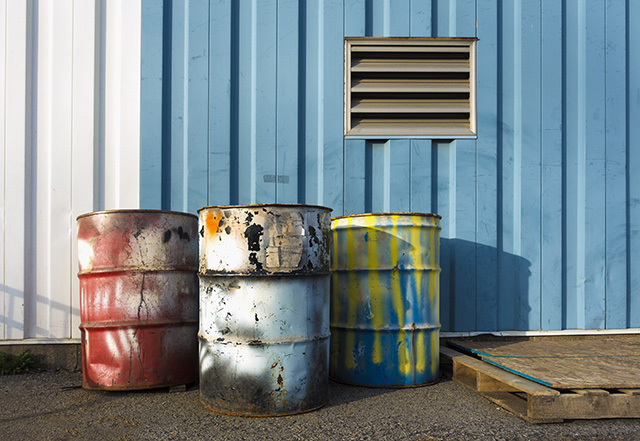A handy tip sheet on the best way to store fuel…just in case
06/04/2018 / By Zoey Sky

Fuel storage is an important thing to consider, especially if you want to stay prepared before SHTF, or even if you just want to make sure that you have access to fuel for home use. (h/t to ModernSurvivalBlog.com.)
Fuel storage options
If you want to store gasoline, take note that it is a difficult fuel to store for a long time. Gasoline can go stale and it has a high vapor pressure, meaning it can quickly evaporate.
Unless chemically treated, gasoline can become stale after several weeks. Ideally, stored gasoline must be treated with a fuel stabilizer additive.
Here are some important tips to keep in mind if you’re going to store gasoline:
- Don’t replace kerosene with gasoline. The two aren’t interchangeable.
- Don’t smoke when handling gasoline.
- Don’t store gasoline in glass containers.
- Don’t store gasoline in non-reusable plastic containers, like milk jugs.
- Don’t use gasoline inside your home.
- Keep gasoline away from children.
- Keep your fuel of choice away from other fuels.
- Refill portable gasoline containers outdoors.
- Regularly check gas cans for leaks.
- Store gasoline in gas cans.
- Store gasoline outside.
If you’re going to use a buried tank, keep it below the frost line where temperatures are stable at about 55 degrees Fahrenheit to inhibit evaporation. Another option is above ground storage. (Related: Low-tech transportation tools for the prepper: Do you have a wagon, wheelbarrow or yard cart?)
For above-ground storage, fuel can be stored in 55-gallon steel drums. The drums can be mounted vertically with a hand pump, or horizontally on a rack with a spigot valve.
Sponsored solution from the Health Ranger Store: The Big Berkey water filter removes almost 100% of all contaminants using only the power of gravity (no electricity needed, works completely off-grid). Widely consider the ultimate "survival" water filter, the Big Berkey is made of stainless steel and has been laboratory verified for high-efficiency removal of heavy metals by CWC Labs, with tests personally conducted by Mike Adams. Explore more here.
Compared to underground storage, above-ground storage is more portable.
Store fuel in a shaded area because sunlight will hasten the oxidation process of the fuel. Meanwhile, temperature swings can cause condensation to form at the bottom of the container. To avoid this, keep a valve at the bottom so you can drain the condensation.
Keep tanks full to prevent condensation. If you’re worried about condensation, a fuel filter at the output valve to separate water from the fuel.
When storing fuel underground, keep in mind that even a 55-gallon steel drum will eventually leak. This can be remedied by storing fuel in a designated underground storage tank (UST). If you don’t have access to one, coat the tank exterior with several coats of rust inhibitor and/or a thick coat of heavy roofing tar. This can help prevent any leakage.
Never use Poly drums for fuel storage. Poly drums should only be used for storing water because they are made of high-density plastic. Fuel will react with the plastic and it can start to deteriorate the drum interior.
The Environmental Protection Agency‘s (EPA) regulations state that the containers below don’t need to meet federal requirements for USTs:
- Emergency spill and overfill tanks
- Farm and residential tanks of 1,100 gallons or less with motor fuel used for non-commercial purposes
- Flow-through process tanks
- Septic tanks and systems for collecting stormwater/wastewater
- Tanks containing heating oil used on the premises where it is stored
- Tanks on or above the floor of underground areas (e.g., basements or tunnels)
- Tanks with a capacity of 110 gallons or less
Another fuel that you can store is kerosene. It is versatile, and kerosene is one of the easiest fuels to store. Kerosene won’t evaporate as quickly as gasoline. One benefit of storing kerosene is it doesn’t require special treatment before storage. If necessary, kerosene can even replace diesel.
The best method for storing fuel
All things considered, the best way to store fuel is outdoors is in gas cans kept in a shaded outdoor area, like a ventilated shed or out-building.
Use approved 55-gallon USTs when storing fuel underground. Although they can be more expensive than an ordinary steel drum, fiberglass reinforced tanks are best for fuel storage. Rotate the fuel in your storage and use fuel stabilizers when necessary.
With these tips in mind, start storing fuel in your home or bug out location so you can stay one step ahead of disasters or fuel supply shortages.
You can read more articles with tips about proper fuel storage at Preparedness.news.
Sources include:
Tagged Under: Collapse, disaster, fuel, fuel storage, fuel tanks, gas cans, gasoline, how-to, kerosene, off grid, preparedness, prepper, prepping, SHTF, steel drums, storage methods, survival, Survival Tips, survivalist, Underground Storage Tanks




















